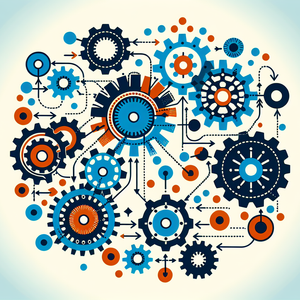Beyond the Numbers: The Art of Data Storytelling

Data storytelling holds immense value in the contemporary landscape for several reasons: 1. Bridging the Gap: One of the primary challenges organizations face is the disconnect between complex data and decision-makers who may lack a technical background. Data storytelling helps bridge this gap, presenting insights in a narrative format that is accessible and relatable. By contextualizing data within a story, analysts can foster a deeper understanding among stakeholders, enabling them to make informed decisions. 2. Enhancing Engagement and Retention: Humans are inherently wired to remember stories more effectively than isolated facts. When data is woven into a narrative, it becomes easier for audiences to grasp the implications and retain the key takeaways. This engagement is crucial in ensuring that insights lead to actionable outcomes. 3. Driving Actionable Insights: In a world inundated with data, the ability to distill information into a clear and concise message is paramount. Data storytelling empowers analysts to highlight critical insights that can influence business strategies, ensuring that decision-makers can act on the information presented.
Techniques of Data Storytelling
To craft compelling stories from data, analysts employ a variety of techniques: 1. Understanding the Audience: The foundation of effective data storytelling lies in understanding the audience. Analysts must identify what information is relevant to stakeholders and tailor the narrative to address their priorities, pain points, and interests. This audience-centric approach ensures that the story resonates and prompts action. 2. Identifying the Core Message: Every great story has a central theme, and data analysts must distill complex datasets into a clear and actionable message. By honing in on a specific insight or conclusion, analysts can create narratives that are both engaging and relevant, guiding stakeholders toward informed decisions. 3. Using Visuals Effectively: Visualizations are integral to data storytelling. Charts, graphs, and infographics can enhance understanding and retention by illustrating complex data in a digestible format. Effective visuals complement the narrative, highlighting key points without overwhelming the audience with excessive information. 4. Creating a Narrative Arc: Just like traditional storytelling, data storytelling should follow a structured narrative arc—beginning, middle, and end. Analysts can start by setting the context, presenting the data and insights, and concluding with actionable recommendations or predictions. This structure helps maintain the audience's attention and facilitates comprehension. 5. Incorporating Emotion: A powerful data story often evokes emotion. By integrating human elements—such as customer testimonials, case studies, or real-world implications—analysts can create a stronger connection with their audience. This emotional resonance can significantly enhance the impact of the insights presented.
Real-World Examples
Several organizations have effectively harnessed the power of data storytelling to drive business decisions: - Spotify’s Year in Review: Spotify’s annual Wrapped feature offers users personalized data about their listening habits. By presenting this information in a visually engaging manner and allowing social sharing, Spotify creates an emotional connection with its users, enhancing brand loyalty and user engagement. - Gapminder: Founded by Hans Rosling, Gapminder utilizes data visualizations to illustrate global development trends. By showcasing changes in life expectancy, income, and education over time, Gapminder effectively communicates complex data in an engaging and informative way, making it accessible to a broader audience. - Coca-Cola’s Happiness Report: Coca-Cola’s marketing campaign centered around happiness utilized data collected from surveys worldwide. By connecting insights about consumer sentiments to their brand narrative, Coca-Cola created a resonant campaign that appealed to emotions and consumer values, ultimately driving brand loyalty and sales.
In conclusion, the role of data analysts has evolved significantly, positioning them as vital storytellers within organizations. By mastering the art of data storytelling, analysts can transform complex datasets into compelling narratives that resonate with stakeholders, drive decision-making, and influence strategies. As businesses continue to navigate an increasingly data-driven landscape, the ability to tell a story with data will become an invaluable skill, ensuring that insights are not only understood but also acted upon. Embracing this narrative approach can unlock the true potential of data, making it a powerful tool for change and innovation. As the demand for data analyst jobs continues to rise, organizations that cultivate this storytelling capability will likely stand out in the marketplace, leveraging their data not just for insights, but for impactful narratives that drive success and growth.
Data Storytelling Specialist
Marketing agencies, tech companies, consulting firms (such as Deloitte and McKinsey)
Core Responsibilities
Create compelling narratives from complex datasets tailored to diverse audiences.
Develop and design engaging presentations and visualizations that transform data into actionable insights.
Collaborate with marketing and product teams to integrate data-driven storytelling into campaigns.
Required Skills
Proficiency in data visualization tools (e.g., Tableau, Power BI) and storytelling frameworks.
Strong communication skills, both written and verbal, to effectively convey insights.
Understanding of audience needs and ability to adapt messaging accordingly.
Business Intelligence Analyst
Corporations in finance, retail, and technology sectors (e.g., Amazon, JPMorgan)
Core Responsibilities
Analyze business data to identify trends, patterns, and actionable insights that inform strategic business decisions.
Develop dashboards and reports that facilitate data-driven decision-making across departments.
Work closely with stakeholders to understand data needs and provide tailored solutions.
Required Skills
Strong analytical skills with experience in SQL and data querying languages.
Familiarity with business intelligence tools (e.g., Looker, Microsoft Power BI).
Ability to present data findings in a visually appealing and easily digestible format.
Data Visualization Developer
Tech companies, data analytics firms, and government agencies (e.g., Google, Tableau)
Core Responsibilities
Design and develop interactive data visualizations and dashboards to communicate insights effectively.
Collaborate with data analysts to understand data sets and translate them into visual formats.
Optimize visualizations for usability and accessibility, ensuring they meet user needs.
Required Skills
Proficiency in programming languages such as JavaScript, D3.js, or Python for creating visualizations.
Strong graphic design skills and an eye for aesthetic presentation.
Experience with UX/UI principles to enhance user interaction with data.
Data Analyst with a Focus on Consumer Insights
Retail brands, e-commerce platforms, and market research firms (e.g., Nielsen, Procter & Gamble)
Core Responsibilities
Gather and analyze consumer data to uncover insights that drive marketing strategies and product development.
Conduct surveys and interviews to complement quantitative data with qualitative insights.
Present findings to marketing teams, highlighting trends that influence customer behavior.
Required Skills
Expertise in statistical analysis tools (e.g., SPSS, R) and qualitative research methodologies.
Strong storytelling ability to convey complex insights in a relatable manner.
Familiarity with CRM systems and marketing automation tools.
Marketing Data Scientist
Digital marketing agencies, tech startups, and large corporations (e.g., Facebook, Adobe)
Core Responsibilities
Leverage advanced analytical techniques to analyze marketing data and assess campaign effectiveness.
Develop predictive models to optimize customer targeting and engagement strategies.
Collaborate with cross-functional teams to design experiments and analyze results.
Required Skills
Proficiency in data science programming languages (e.g., Python, R) and machine learning techniques.
Strong statistical background and experience with A/B testing methodologies.
Ability to communicate technical findings to non-technical stakeholders effectively.


